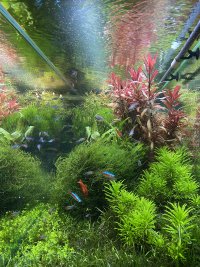Hi all,
I'm not a CO2 user because I don't want rapid plant growth and I favour a <"risk management approach"> to fish keeping. I see accidental asphyxiation as a risk factor when you add CO2, but I don't see the pH fall as a risk.
When you inject CO2 a very small proportion of that added CO2 goes into solution as carbonic acid (H2CO3), and that carbonic acid disassociates into a bicarbonate ion (HCO3-) and a hydrogen ion or proton (H+) (I'm going to ignore the hydronium ion for this reply). Acids are defined as <"proton donors"> so the pH falls.
If we have "carbonate buffering" (dKH) some of that goes into solution and two of the "spare" H+ joins with the carbonate ion CO3 (base or "proton acceptor") to form 2HCO3 and we go back to the <"pH equilibrium point">.
The pH equilibrium point for water, with some dKH, is ~pH 8, but this is dependent upon the level of dissolved CO2, and that level is dependent upon the level of CO2 in the atmosphere. When we add CO2 we mimic a more CO2 rich atmosphere and the pH falls.

The addition of CO2 does <"have effects on snails">. When the pH is below pH7 calcium carbonate (CaCO3) will go into solution and they begin to show shell erosion. This is the same mechanism that could lead to <"coral reef collapse"> if <"atmospheric CO2 levels keep on rising">.
cheers Darrel
Yes you are right <"it does">. This is actually how a <"drop checker"> works.Surely adding CO2 will decrease the PH
I'm not a CO2 user because I don't want rapid plant growth and I favour a <"risk management approach"> to fish keeping. I see accidental asphyxiation as a risk factor when you add CO2, but I don't see the pH fall as a risk.
When you inject CO2 a very small proportion of that added CO2 goes into solution as carbonic acid (H2CO3), and that carbonic acid disassociates into a bicarbonate ion (HCO3-) and a hydrogen ion or proton (H+) (I'm going to ignore the hydronium ion for this reply). Acids are defined as <"proton donors"> so the pH falls.
If we have "carbonate buffering" (dKH) some of that goes into solution and two of the "spare" H+ joins with the carbonate ion CO3 (base or "proton acceptor") to form 2HCO3 and we go back to the <"pH equilibrium point">.
The pH equilibrium point for water, with some dKH, is ~pH 8, but this is dependent upon the level of dissolved CO2, and that level is dependent upon the level of CO2 in the atmosphere. When we add CO2 we mimic a more CO2 rich atmosphere and the pH falls.
I wouldn't ever add CO2 if I kept <"Lake Tanganyika cichlids">, but it doesn't appear to worry other fish. As an example to get to "30ppm CO2" Aquascapers aim for a fairly rapid fall of one pH unit for when the lights turn on and an even more rapid rise of one pH unit when the lights go off. I pH changes themselves were deadly they would kill their fish every day and they don't, in fact they have some of the healthiest fish you will ever see. These are @Iain Sutherland's Congo TetraSo surely the alkalinity isn’t the thing affecting the fish it would be the direct addition of CO2 causing a more acidic environment?

The addition of CO2 does <"have effects on snails">. When the pH is below pH7 calcium carbonate (CaCO3) will go into solution and they begin to show shell erosion. This is the same mechanism that could lead to <"coral reef collapse"> if <"atmospheric CO2 levels keep on rising">.
cheers Darrel





